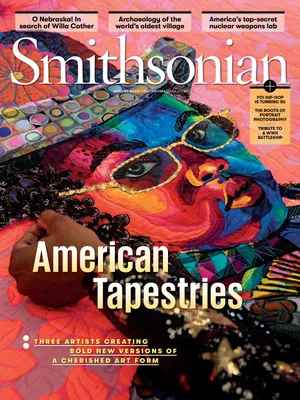OFFICE OF THE SECRETARY OF THE SMITHSONIAN
Who Claims the American West?
A new exhibition at the Smithsonian American Art Museum challenges the old mythology of the frontier
:focal(960x544:961x545)/https://tf-cmsv2-smithsonianmag-media.s3.amazonaws.com/filer_public/ff/31/ff318cbb-038e-4945-a63d-ce7832b48479/untitled-1.jpg)
Some of my earliest work as a historian happened in California, where I curated exhibitions about the creation, disruption and resilience of Black communities in Los Angeles.
The current exhibition “Many Wests: Artists Shape an American Idea,” at the Smithsonian American Art Museum, tackles some of the questions that once consumed much of my time: What draws communities to settle in the West? How do new and Native American populations shape the region, and why are aboriginal contributions so frequently omitted from popular history? Why are the mythologized narratives of Manifest Destiny and cowboys and Indians so resistant to change?
Under the stewardship of the Art Bridges Cohort Program, which fosters partnerships among museums to create collaborative exhibitions, the Smithsonian American Art Museum co-curated an expansive, multimedia experience with four museums in fast-growing areas of the western United States: the Boise Art Museum in Idaho; the Whatcom Museum in Bellingham, Washington; the Jordan Schnitzer Museum of Art at the University of Oregon; and the Utah Museum of Fine Arts at the University of Utah. For the past two years, the exhibition has stopped at each location; on July 28, it will open at our American Art Museum, its final venue.
The exhibition is curated around three major categories: Boundary Breakers, which examines diverse ways of disrupting the popular understanding of the American West; Memory Makers, which focuses on sharing stories across generations; and Caretakers, with the theme of preserving land and cultures. This stunning collection highlights communities often marginalized or excluded from the vernacular of the West; it features artists who identify as Black, Indigenous, Asian American, Latino and LGBTQ.
For his Cowboy and “Indian” Film, Raphael Montañez Ortiz spliced scenes from the 1950s movie Winchester ’73 and reassembled the footage out of sequence and at points upside down, literally turning the racist mythology on its head. Other works offer up neglected histories: Roger Shimomura’s American Infamy #2 is a painting of a Japanese internment camp, where the artist and his family were incarcerated for more than two years following the attacks on Pearl Harbor. Still others effortlessly claim the land for their communities: For Laura Aguilar’s Nature Self-Portrait series, she turns the lens on herself, a queer person of Mexican descent, at ease in the American Southwest.
The collection asks viewers to reconsider who stakes claim to the American West, deconstructing damaging myths and revealing something far more expansive, essential and truthful in their place.
